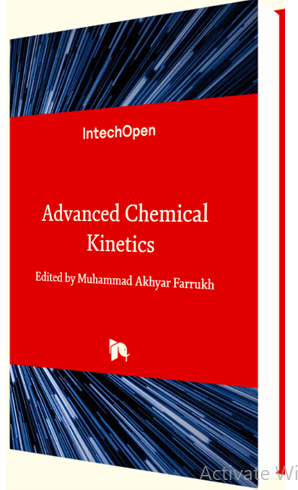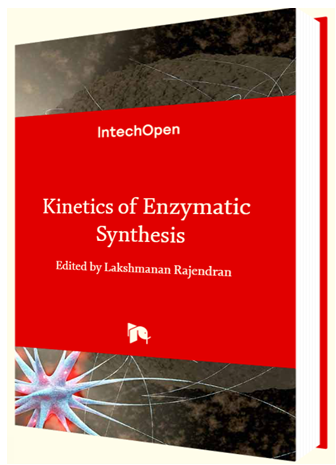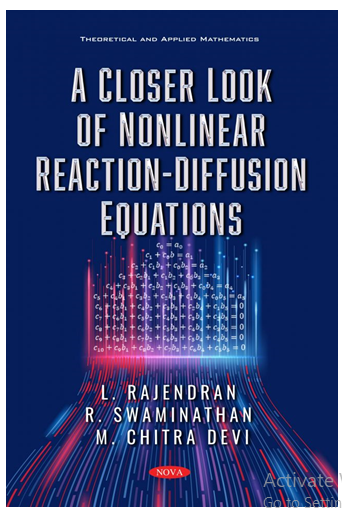Mathematical Modeling and Simulation of Nonlinear Process in Enzyme Kinetics
Lakshmanan Rajendran ,Mohan Chitra Devi
Carlos Fernandez and Qiuming Peng
From the Edited volume: Advanced chemical kinetics
Edited by Muhammad Akhyar Farrukh
This chapter concerns a deep and analytical understanding of the enzyme kinetics has attracted a great attention of scientists from biology, medicine, chemistry, and pharmacy. Mathematical models of enzyme kinetics offer several advances for this deep and analytical understanding due to their in compensable potential in predicting kinetic processes and anticipating appropriate interventions when required.
This chapter concerns mathematical modeling analysis and simulation of enzyme kinetics. Experimental data and available knowledge on enzyme mechanics are used in constituting a mathematical model. The models are either in the form of linear or nonlinear ordinary differential equations or partial differential equations. These equations are composed of kinetic parameters such as kinetic rate constants, initial rates, and concentrations of enzymes. The nonlinear nature of enzymatic reactions and a large number of parameters have caused major issues with regard to efficient simulation of those reactions.
In this book, an enzymatic system that includes Michaelis-Menten and Ping Pong kinetics is modeled in the form of differential equations. These equations are solved numerically in which the system parameters are estimated. The numerical results are compared with the results from an existing work in literature.
Sections
1.Introduction, 2.Reaction diffusion systems, 3.Nonlinear phenomena, 4. Common geometries and nonlinear reaction, 5.Analytical solutions, 6.Numerical solutions, 7.Summary
DOI: 10.5772/intechopen.70914


Kinetics of Enzymatic Synthesis
ACADEMIC EDITOR: Lakshmanan Rajendran
CO-EDITOR: Carlos Fernandez
Kinetics of Enzymatic Synthesis gives insight into different aspects of chemical reactions that are catalyzed by enzymes. This book is divided into two sections: “Enzyme Kinetics” and “Enzymatic Synthesis”. The first section consists of two chapters with a halophilic enzyme kinetics and thermodynamic approach towards analyzing the influence of co-solvents on the Michaelis constants of enzyme-catalyzed reactions. The second section consists of three chapters. Production of isoamyl acetate using the enzymatic synthesis method between acetic anhydride and isoamyl alcohol by having enzyme Candida antarctica Lipase B as catalyst in a solvent-free system is discussed in the third chapter. The integrated scheme with the use of the filtrate from the pretreatment of the CS and the growth conditions of Pleurotus cystidiosus is studied in the fourth chapter. The last chapter of this section provides the conditions of the key parameters in microfluidic systems (residence times, flow rates, concentrations) applied for a sequential process from liquid/liquid extraction of LVV-h7.
DOI: 10.5772/intechopen.76270
A Closer Look of Nonlinear Reaction-Diffusion Equations
L. Rajendran, R.Swaminathan and M. Chitra Devi
Recently non-linear differential equations were widely used to model many of the interesting and relevant phenomena found in many fields of science and technology on a mathematical basis. This problem is to inspire them in various fields such as economics, medical biology, plasma physics, particle physics, differential geometry, engineering, signal processing, electrochemistry and materials science.
This book contains seven chapters and practical applications to the real world’s problems. The first chapter is specifically for those with little mathematical background with the introduction of non-linear reaction-diffusion systems, various boundary conditions and examples. The real-life application of non-linear reaction-diffusion in different fields with important non-linear equations is also discussed. In Chapter 2, mathematical preliminaries and various advanced methods of solving non-linear differential equations such as Homotopy perturbation method, variational iteration method, exponential function method etc., are described with examples
Steady and non-steady state reaction-diffusion equations in the plane sheet (chapter 3), cylinder (chapter 4) and spherical (chapter 5) are analyzed. The analytical results published by various researchers in referred journals during 2007-2020 have been addressed in these chapters 4 to 6, and this leads to conclusions and recommendations on what approaches to use on non-linear reaction-diffusion equations.
Convection-diffusion problems arise very often in applied sciences and engineering. Non-linear convection-diffusion equations and corresponding analytical solutions in various fields of chemical sciences are discussed in chapter6. Numerical methods are used to provide approximate results for the non-linear problems, and their importance is felt when it is impossible or difficult to solve a given problem analytically. Chapter 7 identifies some of the numerical methods for finding solutions to non-linear differential equations.
Nova publishers (2020),
Series: Theoretical and Applied Mathematics
DOI: 10.52305/RRSY7475
https://novapublishers.com/shop/a-closer-look-of-nonlinear-reaction-diffusion-equations/
